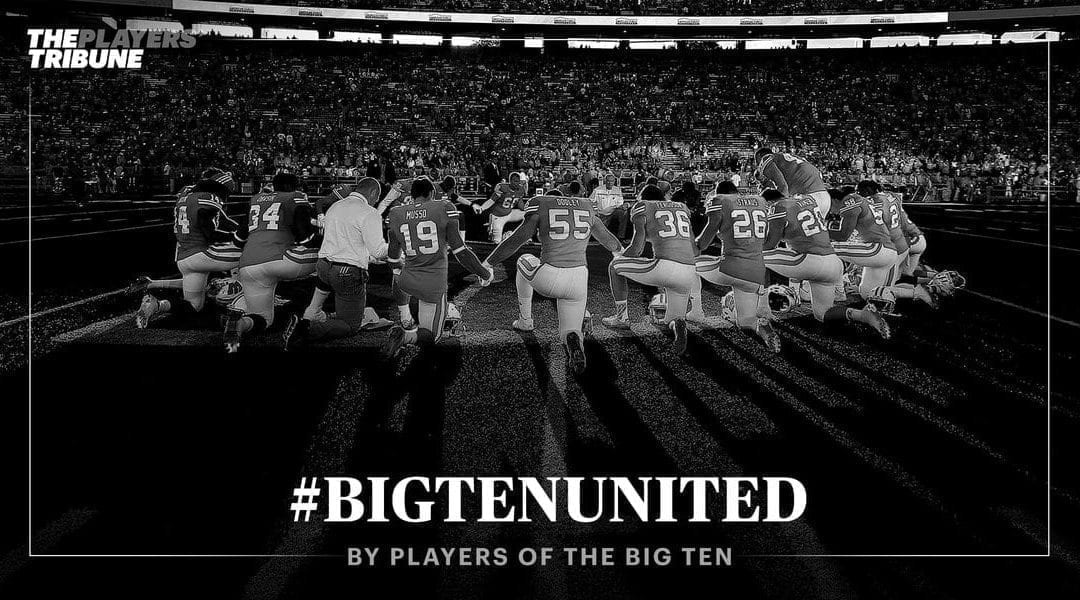The sport of college football has always been a house of cards. As exponential growth in television revenue fueled spending sprees across college campuses, the house grew and grew. It seemed like everyone was benefitting. Athletics departments splurged as facilities for football, and other sports, grew bigger and more lavish. Coaches signed contracts worth tens of millions of dollars. Little of this gets paid for with cash that the schools have on hand. Some of the funding comes in the form of contributions from donors who love seeing their favorite school compete [win]. Much of it is debt service based on future revenues, mostly from television rights, that are expected to keep growing.
But it was, and still is a house of cards. That’s because at its foundation college football is entirely reliant upon unpaid labor. Yes, college football players receive scholarships, housing at school, medical care while playing, and they get to use those lavish facilities; all free of charge. Many believe that is its own form of payment to those whose unique talents and hard work rake in the tens of millions needed to pay for it all. Others say a college education doesn’t fairly compensate players for their contributions and risks, and when you factor in some of the NCAA’s and individual school’s restrictive rules, it almost turns college football into a form of indentured servitude.
Whichever side you fall on, or if it’s somewhere in between, once thing has always been true – the whole house is entirely dependent on the players’ willingness to accept things the way they are and play football. But the coronavirus pandemic has shaken that foundation, and the house could be set to crumble.
Schools that are desperate to keep at least some of the cash flowing have been trying to figure out ways to safely play a football season – or at least give the public the appearance that they are doing all they can. Many schools have acknowledged that they will not be able to have a stadium full of paying fans this season, for many schools the second-largest source of football revenues after television. But in many cases that choice was already made for them by the leadership of their state in the forms of limits/restrictions on mass gatherings. Three of the Power 5 conferences have announced they will only play games within their conference this season. But who the opponent is doesn’t make the players safer – it just makes it easier for the conference to juggle the schedule to squeeze-in as many money-making games as they can if a particular team has a COVID-19 outbreak.
Programs across the country are doing regular testing of all student athletes, and some football programs have suspended preparations for the season due to outbreaks (most recently three Big Ten teams: Michigan State, Northwestern and Rutgers). All positive cases are being safely isolated and given proper medical attention and, if necessary, treatment.
But what if the players still decide they just don’t feel safe playing? Without them, there is no college football. There are currently over 10,000 scholarship players at the FBS level, and never have they had the impetus to unify in numbers large enough to make a difference. That might be changing. On August 2 the players of the Pac-12 began the #WeAreUnited movement with an article in The Players’ Tribune outlining a list of demands they want met, or else they’ll elect not to play this season. Some of their demands pertain specifically to COVID-19 safety measures. Some pertain to eliminating racial injustices. Also included was a demand to distribute 50% of revenues generated by each sport evenly amongst the respective players. Three days later, players from the Big Ten published their own Players’ Tribune article titled #BigTenUnited outlining their own demands; though their’s were solely devoted to COVID-19 issues.
Then in an ironic twist, on August 5 the NCAA lent a huge assist to players seeking to exercise their leverage. They released a list of requirements for all member institutions to follow for the 2020 fall sports season, though they punted on what was expected to be their main topic of discussion: cancelling fall sports tournaments (which will now be up to each the 3 separate divisions). The items that did make the list included the establishment of a whistleblower hotline for students and parents to notify the organization of violations, a prohibition on forcing players to waive their legal rights for COVID-related issues, and perhaps most importantly, allowing any player to opt-out of playing this season without sacrificing their scholarship. So basically players can now elect not to play, but still attend school for free. And several players have already announced they will do just that, including NFL prospects like VA Tech CB Caleb Farley, Minesota WR Rashod Bateman, and Penn State LB Micah Parsons.
So now we sit and wait to see whether this is the start of a landscape-shifting change in college football (and by extension all of college athletics), or if the #united movement quickly loses steam and this is just a pandemic-induced blip on the radar. Will more Power 5 players join their Big Ten and Pac-12 peers? How many players will ultimately decide it’s not worth the risk to play this season, particularly NFL prospects who now have to worry about a virus in addition to hoping they avoid a serious injury that could damage their draft status? The state of college football as we have known it hangs in the balance.

College Football Analyst
Mike is a Baltimore native living in Portland, OR since 2007. He currently runs his own business specializing in video production and online marketing. Prior to that he was a legal technology consultant, worked for 9 years at Johns Hopkins University and served 6 years in the Air Force. He also enjoys travel, food, beer, and is a volunteer at the Oregon Humane Society.
